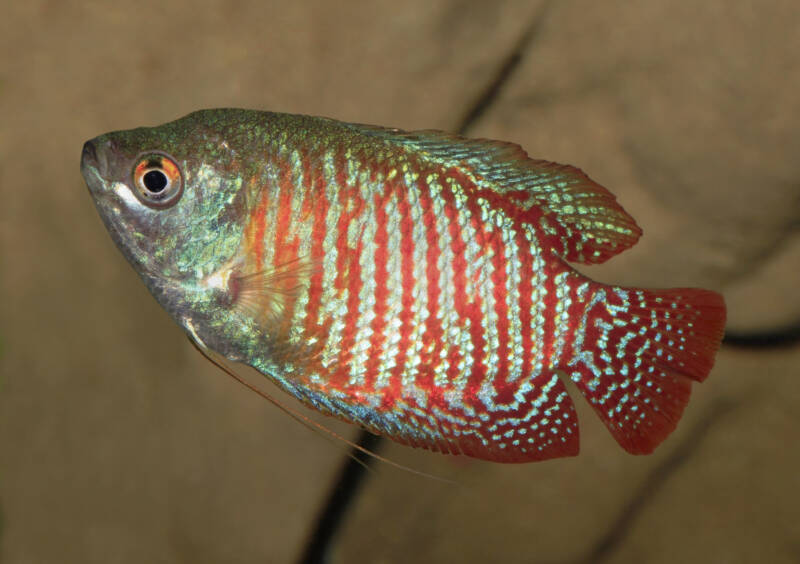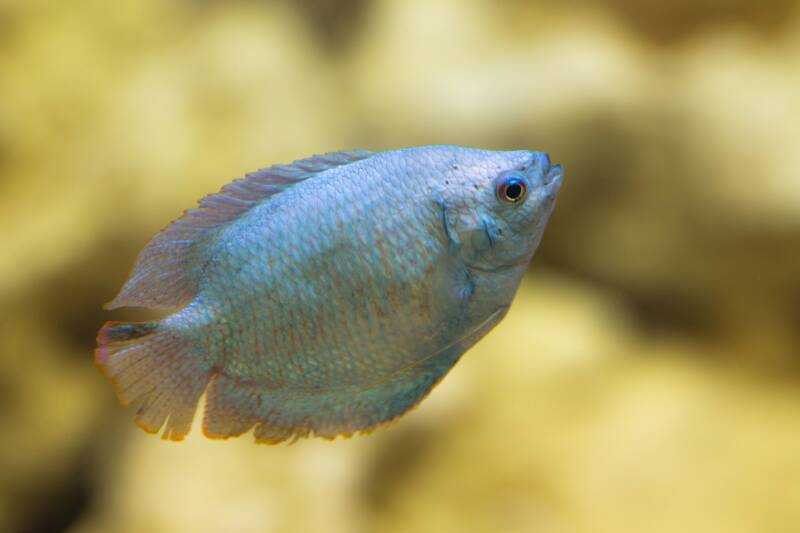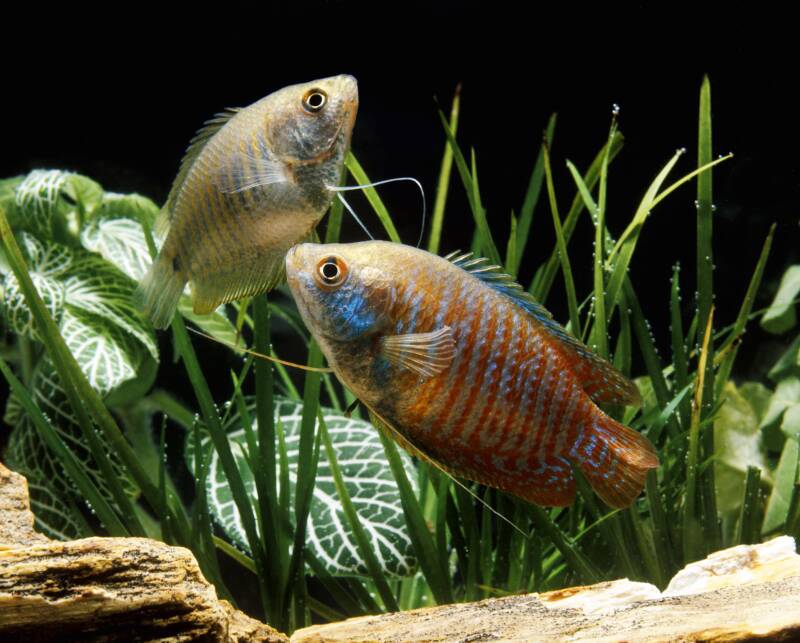Are you looking for a fish with stunning colors and a big personality, but have limited space in your aquarium?
Look no further than the dwarf gourami (Trichogaster lalius)!

As one of the smaller and most brilliantly colored gourami species, it’s no wonder they’re a fan favorite. Plus, they’re the perfect addition to a nano aquarium.
These freshwater fish may be shy at first, but with the right care and environment, they’ll come out of their shells and show off their vibrant hues and unique personalities.
However, beware – dwarf gouramis are quite sensitive to changes in water quality and chemistry, making them prone to bacterial infections.
To ensure these little beauties thrive in your tank, keep reading for tips on their care.
At a Glance
| Adult Size: | 3 inches (7,6 cm) |
| Minimum tank size: | 15-20 gal |
| Water temperature: | 72-82°F (22-28°C) |
| Lifespan: | 5 years |
| pH: | 6.0-7.0 |
| Behavior: | Semi-peaceful |
| Diet: | omnivorous |
[toc]
Origins
Wild dwarf gouramis can be found in the Asian regions of Pakistan, Bangladesh, and Northern India.
They inhabit slow-moving, shallow, and acidic waters, including streams, ponds, and swamps. These waters are densely planted and contain plenty of driftwood and loose sticks to provide cover for cautious fish.
One last quality of their habitat that should be noted is the low levels of oxygen in the water. For most fish, this would be a major problem. Gouramis have adapted to this environment with the help of their labyrinth organ, which will be further explained later.
Appearance
There are two main variations of dwarf gouramis: the Neon and the Powder Blue.
Neon dwarf gourami

The neon dwarf gourami is characterized by the striking orange striped pattern that occurs on the body and fins.
The main pattern is made up of blue and orange stripes. The patterns on the fins are more sporadic and random.
The top of the dorsal fin is usually edged with an iridescent blue shade, as is the first third of the pelvic fin. The remaining fins are solid orange with blue dots.
Powder blue dwarf gourami
The powder blue dwarf gourami has a solid light blue coloration.
Some powder blues are completely blue with no distinguishable pattern.

Others have markings similar to that of a neon gourami but with the colors reversed.
The body of this fish has a blue base color with vertical light-orange stripes. The fins are blue with orange dots and slight orange edging.

Appearance Biology
Just like bettas and other anabantoids (also known as labyrinth fish), dwarf gouramis primarily breathe using their labyrinth organ.
This organ is located in the head just behind the eyes and is very useful for fish that live in low-oxygen environments.
Being obligate air breathers, gouramis cannot get enough oxygen from their gills alone.
To make up for this, gouramis swim up to the surface and gulp down air whenever they’re in need of oxygen!
Similar to lungs in a person, once inhaled, the air gets processed by the labyrinth organ. The extracted oxygen is directly absorbed into the fish’s bloodstream.
Another cool attribute of the dwarf gourami species is the little sensory appendages that appear just below the pectoral fins.
They function just like the barbels on the faces of corydoras. These feelers can reach several inches in length and aid in searching for food and navigating tough terrain.
Behavior
Although peaceful with other species, dwarf gouramis can be very territorial toward other gourami and anabantoids.
But provided the right habitat and tank mates, dwarf gourami can make excellent centerpiece fish for your tropical community.
Gourami is a shy fish, and too many tank mates with too little plant coverage can place undue stress on it. You’ll want to make sure your tank is adequately planted.
A good starting place for a densely planted aquarium is to have at least 50% of the water volume completely occupied by plants, but more is better!
Broad-leaved plants like amazon swords produce ample hiding spaces.
Floating plants, driftwood, and rocks also provide important out-of-sight places and a form of natural enrichment.

Tank Size
It’s best to use at least a 20-gallon tank if housing dwarf gouramis with other fish species. That will give them enough room to establish their territory.
Anything smaller is best done as a single-species tank. 15 gallons is the minimum size for housing a single dwarf gourami.
Tank Mates
Plenty of species are compatible with this freshwater fish. Bottom-dwelling fish are your best option here, as gouramis do not spend a lot of time at the bottom of the tank.
Fish like corydoras, kuhli loaches, black loaches, and plecostomus are all good options. Some middle-of-the-tank dwellers that cohabitate peacefully with dwarf gourami include:
- Harlequin Rasboras
- Dwarf Rasboras
- Neon Tetra
- Black Neon Tetra
- Rummy Nose Tetra
- Bloodfin Tetra
- Cherry Barbs
- Gold Barbs
Dwarf gouramis should not be housed with aggressive fish or any fish that are larger than them. Flashy fish should also be avoided as they can be seen as competition to any “proud” males.
Here is a list of fish species that cannot be housed with dwarf gouramis:
Feeding
A varied diet is crucial. Dwarf gouramis are omnivorous and can be found eating small insects and worms as well as grazing on algae.
Live and frozen foods such as bloodworms, daphnia, brine shrimp, mysis shrimp, and captive-raised mosquito larvae all make healthy fish food.
Pellets and flake food for tropical fish like Omega One’s Freshwater Flakes and Bug Bites Tropical Formula add extra, necessary nutrients to a dwarf gourami’s diet.
Algae wafers and veggie wafers are simple ways to contribute to the plant-based part of their diet.
Dwarf Gourami Tank Setup

Whether you’re planning a species-only or community tank, plants are a must. Dwarf gouramis do best when they have constant access to hiding places. Big, broad-leafed plants like swords are popular choices. Anubias, Java Fern, Vals, and Bacopa all provide good coverage.

Soft, acidic water is also a must. This can be achieved by adding driftwood and other botanicals to the freshwater tank.
Alternately, you can bring down your pH by buying a Reverse Osmosis filter or using a bottle of API’s pH Down.
Although providing a more natural process, Reverse Osmosis systems can be pretty pricey so purchasing a bottle of pH Treatment may be the better option here.
However, the bottle is not a perfect solution for water hardness and other tank conditions. Particularly hard water may necessitate the filter.
Dwarf gouramis do well being the only gourami in the aquarium. They should only be housed with another gourami if they have enough room to establish separate territories.
A heavily planted tank that can hold 40 gallons will provide enough space for a pair or trio. It is recommended to keep them in male/female pairs or have one male to every two females.
Two males in a tank can be very violent and territorial towards one another, so it’s best to avoid it if possible. Just look at the video below:
Dwarf gouramis are not fond of too much water flow as they naturally inhabit slow-moving or stagnant waters.
Standard HOB (Hang on Back) filters usually don’t put out too much current, but if you notice your gourami being pushed around, it may be necessary to switch to a sponge filter or alter the flow with a homemade baffle.
As for substrate, dwarf gouramis are not picky. Since they spend most of their time in the middle or top of the tank, they do not require any specific substrate type. Sand or gravel will work just fine.
Optimal lighting can range from low to moderate. If you have strong lights, your gouramis may benefit from top floating plants to filter out some of that excess light.
Too much light and open space can make this nervous fish even more nervous, adding unnecessary stress.
Disease
The primary disease worth mentioning is Iridovirus, commonly referred to as “Dwarf Gourami Disease.”
Iridovirus is a highly contagious, often fatal viral condition that causes necrosis of the spleen and kidneys. Once infected, the fish’s health will gradually decline until it is no longer able to eat and slowly starves to death.
This disease is widespread because of the mass production and poor breeding practices that take place in order for importers to meet fish stores’ demand for this popular species.
Symptoms of Iridovirus include:
- Loss of color: Affected fish’s color will dramatically fade.
- Lesions: Most often appear internally but can sometimes appear on the outside of the fish.
- Loss of appetite.
- Abdominal swelling: As the spleen becomes more and more enlarged, you will notice a swelling in the abdomen that resembles a stomach bloated from overeating.
- Confusion & disorientation: In the later stages of the disease, the fish will begin having trouble with motor function. Swimming will become erratic, and the fish will be seen laying on its side. Simple tasks like aiming at food or swimming up to the surface will become difficult. The fish may die of starvation or drowning before the actual disease kills it.
It is easy to spot sick and dying individuals in the dwarf gourami tank at a pet store. However, seemingly healthy individuals that have been exposed to infected fish are not so easy to spot.
It is best to avoid purchasing dwarf gourami if you notice any other sick gouramis in the tank.
What should I look for in a healthy gourami?
Healthy gourami will be vibrantly colored with no signs of color loss. They will be very active and alert and show a hearty interest in food.
They should be at an adequate weight – underweight gouramis often look like they have a bent spine or concave shape to the body.
Lastly, you should avoid any fish with any visible damage. Open wounds and torn fins compromise the fish’s immune system, making them more susceptible to unwanted disease and infection.
Sexing
The difference between males and females of this species is slight and appears in the fins and overall body shape.
Males are slightly smaller than the females, with a slimmer frame. The dorsal fin on the male has a pointed end that can match the tail fin’s length.
Females have short, rounded dorsal fins. Their body and belly are rounder overall than the males’.
Breeding
Like bettas, dwarf gouramis are bubble nest builders. When ready to spawn, the male will make a nest at the water’s surface.

He makes these nests out of loose vegetation and bubbles made from his own spit. Most males prefer to make their nests under floating plants or under the broad leaves of large plants that reach the surface.
Gouramis will often breed on their own when paired up with a mate, but here’s what you need to do if you need to induce spawning yourself!
Start by lowering the water level in your tank to around 6-8 inches and raising the temperature to 80-82°F. This should induce spawning.
The male will begin to display himself, flaring at the female to court her. If she accepts, she will guide the male under the nest and prepare for fertilization.
The female gourami will let the male know when she’s ready by nuzzling the male with her feelers and mouth. When releasing the eggs, the female will turn upside down under the bubble nest, and the male will shadow her. As the female releases, the eggs the male simultaneously fertilizes them.
A majority of the eggs will then float up and attach to the nest. The male will collect any eggs that sink to the bottom of the tank and returned to the bubble nest.
The pair will repeat these spawning sessions until all of the female’s eggs have been laid.
At this point, the female should be removed from the tank. The male dwarf will begin guarding the eggs and can become aggressive to the female if she gets too close.
After around 24 hours, the eggs will hatch. It should take about 3 days before the fry leave the nest and begin free-swimming around the tank. At this point, it is advised to remove the male as he may try to consume his young.
Fry can be fed pre-made fry food, egg yolks, and microorganisms such as freshly hatched brine shrimp. There are some excellent prepared fry foods, such as Hikari’s First Bites and New Life Spectrum’s Grow Fry Starter!
Closing Thoughts
The dwarf gourami is a fantastic, flashy fish – certainly a great addition to your tropical aquarium. Whether you keep them by themselves, with other species, or with another gourami, their shy yet curious personality will brighten any sour feelings.
Have any questions, comments, or concerns?
Leave ‘em below, and we’ll get back to you!

